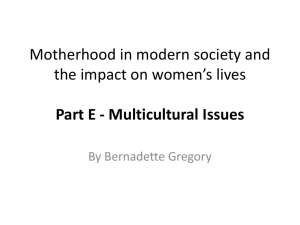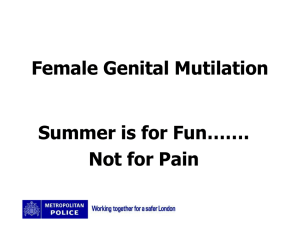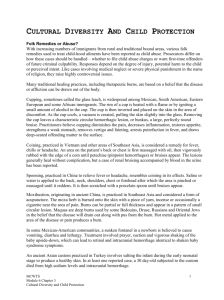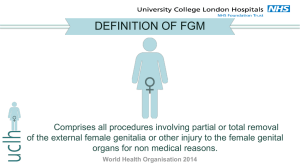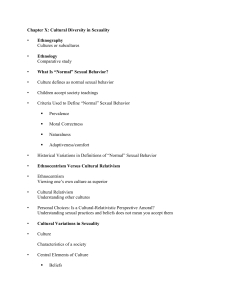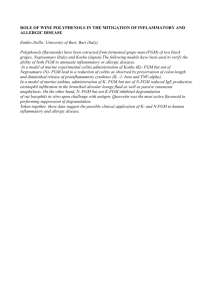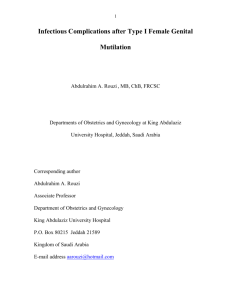Document 14249909
advertisement
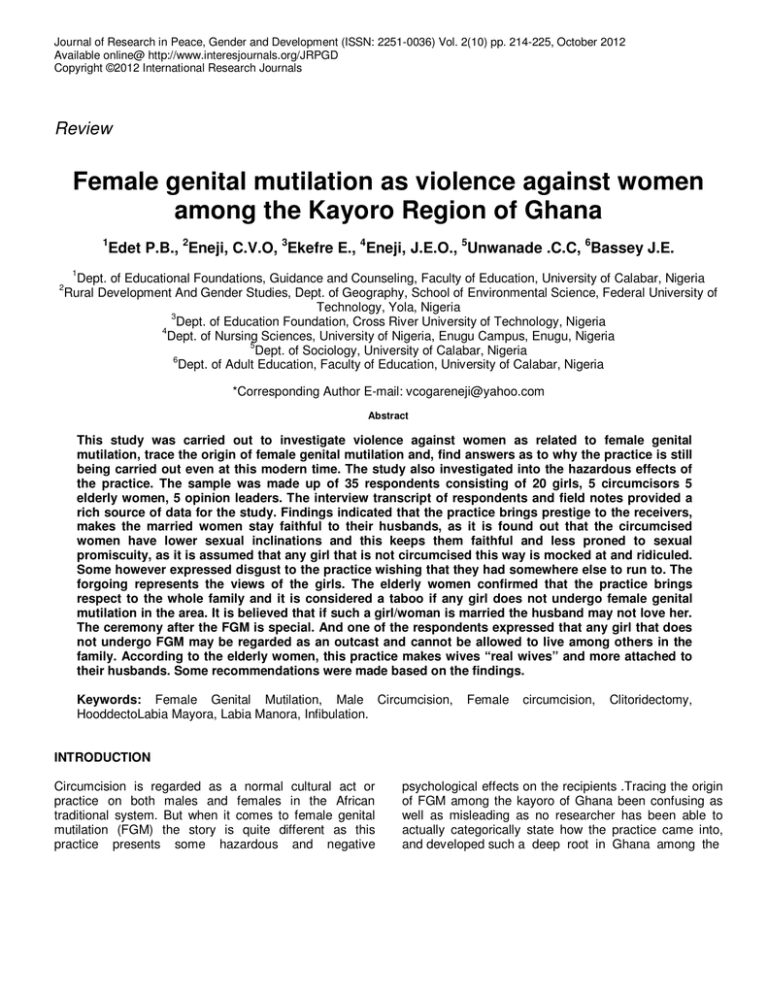
Journal of Research in Peace, Gender and Development (ISSN: 2251-0036) Vol. 2(10) pp. 214-225, October 2012 Available online@ http://www.interesjournals.org/JRPGD Copyright ©2012 International Research Journals Review Female genital mutilation as violence against women among the Kayoro Region of Ghana 1 Edet P.B., 2Eneji, C.V.O, 3Ekefre E., 4Eneji, J.E.O., 5Unwanade .C.C, 6Bassey J.E. 1 Dept. of Educational Foundations, Guidance and Counseling, Faculty of Education, University of Calabar, Nigeria Rural Development And Gender Studies, Dept. of Geography, School of Environmental Science, Federal University of Technology, Yola, Nigeria 3 Dept. of Education Foundation, Cross River University of Technology, Nigeria 4 Dept. of Nursing Sciences, University of Nigeria, Enugu Campus, Enugu, Nigeria 5 Dept. of Sociology, University of Calabar, Nigeria 6 Dept. of Adult Education, Faculty of Education, University of Calabar, Nigeria 2 *Corresponding Author E-mail: vcogareneji@yahoo.com Abstract This study was carried out to investigate violence against women as related to female genital mutilation, trace the origin of female genital mutilation and, find answers as to why the practice is still being carried out even at this modern time. The study also investigated into the hazardous effects of the practice. The sample was made up of 35 respondents consisting of 20 girls, 5 circumcisors 5 elderly women, 5 opinion leaders. The interview transcript of respondents and field notes provided a rich source of data for the study. Findings indicated that the practice brings prestige to the receivers, makes the married women stay faithful to their husbands, as it is found out that the circumcised women have lower sexual inclinations and this keeps them faithful and less proned to sexual promiscuity, as it is assumed that any girl that is not circumcised this way is mocked at and ridiculed. Some however expressed disgust to the practice wishing that they had somewhere else to run to. The forgoing represents the views of the girls. The elderly women confirmed that the practice brings respect to the whole family and it is considered a taboo if any girl does not undergo female genital mutilation in the area. It is believed that if such a girl/woman is married the husband may not love her. The ceremony after the FGM is special. And one of the respondents expressed that any girl that does not undergo FGM may be regarded as an outcast and cannot be allowed to live among others in the family. According to the elderly women, this practice makes wives “real wives” and more attached to their husbands. Some recommendations were made based on the findings. Keywords: Female Genital Mutilation, Male Circumcision, HooddectoLabia Mayora, Labia Manora, Infibulation. Female circumcision, Clitoridectomy, INTRODUCTION Circumcision is regarded as a normal cultural act or practice on both males and females in the African traditional system. But when it comes to female genital mutilation (FGM) the story is quite different as this practice presents some hazardous and negative psychological effects on the recipients .Tracing the origin of FGM among the kayoro of Ghana been confusing as well as misleading as no researcher has been able to actually categorically state how the practice came into, and developed such a deep root in Ghana among the Edet et al. 215 Kayoro indigenes. By reason of its cultural status so many important beliefs have been attached to the practice making it quite difficult to eradicate or even control. The elderly in this society cherish and promote the practice, while the younger ones who are the victims, or potential victims despite it, and even wish they had somewhere else to run to so as to avoid being a subsequent victim. Because of the hazardous effects this practice has on recipients some NGOS and even WHO have illegalized this practice but to no avail because they had been deeply rooted in the socio-cultural lives of the people. Statement of the problem The problem of this study is that of violent against women in relation to female genital mutilation. It is a serious problem because of the hazardous, emotional, physical and other enduring effects this practice exposes the victims to, coupled with the insensibility of the practitioners to heed to the laws banning its continued practice. Purpose of the study The purpose of the study is to investigate into the root causes of the traditional principles and values which have influenced the practice of female genital mutilation in Kayoro. The social psychological, economic, emotional, and physical effects of this practice will also be investigated. Research questions 1. What is the origin of FGM in the area? 2. What factors induce the people of Kayoro to practice female genital mutilation [FGM]? 3. What are the possible benefits /negative effects of FGM on the recipients of this practice? 4. What are he types of female genital mutilation practiced in the area? 5. What are the probable interventions towards this practice in the area? The literature review was organized under the following sub-headings: i. Origins of FGM ii. Types of FGM iii. Cultural and religious factors which influence the practice of FGM iv. Health hazards associated with FGM v. Efforts made by WHO and NGOs to stop and reduce the practice of FGM. The origins of female genital mutilation The attempts to theoretically reconstruct the origins of FGM presents a formidable challenge that too many may seem an exercise in futility, leading one scholar to caution that: even retroactive reconstruction via circumstantial extrapolation is problematic” (Obioral 1997). Scholars differ in their views regarding the importance of such, and maintain that the conditions that led to the initial adoption of female “circumcision” are not static and knowing them will enhance understanding of the perpetuation of the practice (Boddy 1982). To others however, tracing the origin is an essential endeavor and they argue that the question of origin is becoming increasingly important, particularly to African women who uphold the tradition, and are continually finding themselves in a position to justify the practice to outsiders, and perhaps more so, to themselves. Arguing from a different angle a political scientist Mackie (1996) locates its genesis in ancient Meroe [in preset day Sudan], where infibulation was practiced in the context of fidelity control and paternity confidence mechanisms under conditions of imperial female slavery. Dorkenoo (1994) is of the view that female genital mutilation must have developed independently among certain ethnic groups in sub-Saharan Africa as part of puberty rites. Klein (1989) adds that excision practices can be assumed to date back thousands of years but that at some point, these came into conjunction with the obsessive preoccupation with virginity and chastity that today will characterize Islamic-Arabic cultures (Klein 1989). According to Dorkenoo (1992), female genital mutilation is believed to have been introduced to Ghana by migrating populations from the Sahelian countries’ of Burkina Faso, Mali and Niger. Heidi (1999) claim that the prevalence of FGM in Ghana ran between 25 and 35%. In the northern region of Ghana with a population of about one million, there are 14 different ethnic groups among whom genital mutilation is not practiced at all. However, in the same region there are also migrants from neighboring countries such as Togo and Burkina Faso, among whom the practice is carried out [Smith 1992]. It is believed that female genital mutilation [FGM] has its origin in the northern part of Ghana due to the males desire to control females sexuality. In the traditional African societies, it was absolutely necessary for girls to 216 J. Res. Peace Gend. Dev. remain chaste until marriage. Therefore young girls were mutilated to “remove” or prevent any sexual desires, and to ensure their virginity until marriage. According to Dorkenoo and Elworthy (1992) in the olden days, most chiefs in the Kesana- Nankana traditional area of Ghana used to have two or more wives. The chiefs therefore, found it difficult to satisfy all their wives sexually due to their number. For fear that wealthy men would lure their wives sexually into sexual intercourse; they came out with the introduction of female circumcision as a measure of controlling or reducing the sexual desires of their wives. Another version has it that hunters in the Kesana-Nankana area normally left their wives at home for hunting far into the bush for months. During their absence, the desire for sex by their wives may be aroused and temptation for them to look for men could be ruled out when they have undergone FGM. Circumcision was therefore, necessary to reduce their wives’ desires and feelings for sex until their husbands return from hunting. It is however worthy to point out that no definite evidence exists documenting exactly when, and why female genital mutilation began but it is believed to have been introduced into the KesanaNankana area and other areas in the upper East Region of Ghana by a tribe from Burkina Faso and Mali (Dorkenoo and Elworthy, 1992), it can be inferred from the literature review that the origin of FGM is not certain, however, the practice is linked with a cultural practice aimed at controlling the sexual desires of girls and women and this view is held by those who practice FGM. Types of female genital mutilations Female genital cutting or circumcision or mutilation refers to a variety of operations involving partial or total removal of female external genitalia. In 1995, the World Health Organization (WHO) classified Female Genital Mutilation operations into four types based on the severity of structural disfigurement. FGM is most often performed between the ages of 4 and 10 years although in some communities it may be practiced on infants or postponed until just before marriage. Type I Clitoridectomy Type one of Female Genital Mutilation, often termed clitoridectomy, involves excision of the skin surrounding the clitoris with or without excision of part of the entire clitoris. When this procedure is performed in infants and young girls, a portion or all of the clitoris and surrounding tissues may be removed. If only the clitoral prepuce is removed, the physical manifestation of type 1 FGM may be subtle, necessitating a careful examination of the clitoris and adjacent structures for recognition. Type 1 is therefore, the partial removal of the labia minora of the clitoris, which is known as clitoridectomy. Type II Type II FGM, referred to as excision, is the removal of the entire clitoris and part of all of the labia minora. Crude stitches of catgut or thorns may be used to control bleeding from the clitoral artery and raw tissue surface, or mud poultries may be applied directly to the perineum. According to who,[1997] study, patients with Type II FGM do not have the typical; contour to the anterior perinea structures resulting from the absence of labia minora Infibulation (Type III) Infibulation is the most drastic form of circumcision. It is also known as “pharaonic circumcision. “Infibulation involves the cutting of the entire clitoris. Thus the adjacent tissues or labia minora and labia majora are both operated upon. Unlike the clitoridectomy where the labia minora is operated upon, in infibulation’s all or both the labia minora (small lips of the vagina) and the labia majora, that is the large lips of the vagina are both operated upon. When the operation is done the raw edges of the wounds are then sewn together leaving only a tiny opening for urination and menstruation. After the operation, the girl’s legs are bound together and she lies motionless until the wounds are healed. In addition to the three types of mutilation is the unclassified or the Type Four (IV). Unclassified (Type IV) These are the range or forms of surgeries and classified manipulations and practices identified by the WHO. These include pricking, or stretching or incising of the clitoris and or labia burning or radiation of the clitoris, scrapping of tissues surrounding the vaginal orifice (angurya cuts) and cutting of the vagina (igishiri cuts) (WHO;1997). “Angurya” cut are operated at the orifice, which is the foreskin of the opening in which the vagina joins the clitoris. The “igishiri” cuts are operated on the vagina itself (Geneva, WHO 1996). Edet et al. 217 Cultural and religious dimensions associated with female genital mutilation The tradition or cultural practice of FGM predates both Islam and Christianity. A Greek Papyrus from 163 B.C. mentioned that girls in Egypt were undergoing circumcision in Egypt and the Nile valley at the time of the Pharaohs. Also evidence from mummies indicated that there were types 1 and type iii forms of FGM in Egypt before Islam or Christianity. Female Genital Mutilation is a cultural practice. Efforts to end it requires understanding and changing the beliefs and perceptions that have sustained the practice over the centuries irrespective of how, where, and when the practice began. Those who practice it share similar beliefs. The details of these mental maps vary across countries and there are distinctive features to each culture that provides community workers and others involved with the anti-female genital mutilation campaigns need to take into consideration. According to WHO/PATH (1997), this mental map shows the psychology and social reasons and the religious, societal, and (hygienic and aesthetic) beliefs that contribute to the practice. These beliefs involve continuing long standing customs and tradition of maintaining cleanliness, chastity, virginity and upholding family honour, and sometimes perceived religious dictates. Communities have a range of enforcement mechanisms to ensure that the majority of women comply with FGM. These include fear of punishment from the gods, men’s unwillingness to marry uncircumcised women, insistence that women from other tribes get circumcised when they marry into the group, as well as local poems and songs that reinforce the importance of the ritual. In some cases, women who are not circumcised may face immediate divorce or forced excision. Girls who undergo FGM sometimes receive rewards, including public recognition and celebrations, gifts, potential marriage offers, respect and opportunity to engage in adult social functions. Another reason such as a celebration of womanhood, preservation of customs or tradition, or a symbol of ethnic identity has helped to perpetuate the tradition. The ritual cutting is often an integral part of ceremonies, which may occur over several weeks, in which girls are feted and showered with presents and their families are honoured. It is described as a joyous time with many visitors, feasting, dancing, and eating of good food and the creation of an atmosphere of freedom for the girls. The rituals serve as an act of socialization into cultural values and an important connection to family, community and earlier generations. The ceremonies often involve interrelated aspects: educational as the girls take their place in society and their role as women, wives, or mothers. It also entails physical training. The practice is seen as exposing the girls to physical pains to prepare them for their new roles as courageous women and to help them to endure pains at labour. The girls are, therefore, made to undergo vows of silence to make a solemn pledge not to speak about their painful experience during the ceremony to others. Some of the justifications for the practice hinge on the belief that it preserves the virginity and protects marital fidelity because it diminishes sexual desires, practicing communities cite reasons such as giving pleasure to husbands, religious mandate, cleanliness, identity, maintenance of good health and, achieving good social standing as reasons behind the practice. At the heart of all these, it is a form of rendering a woman marriageable which is important in societies where women get their support from male family members especially husbands. A circumcised woman will also attract a favorable bride price, thus benefiting her family. The practice is perceived as an act of love for daughters. Parents want to provide a stable married life for their daughters and ensure their full participation in the community hence forcing their daughters to undergo the practice. For many girls and women, being uncircumcised means that they have no access to status or a voice in their community. Because of the strong adherence to these traditions, many women who disapprove of female genital mutilation still submit themselves and their daughters to the practice. (Geneva: WHO, 1997) The tradition argument concerning the ethnic groups of Ghana indicate that the significance of female genital mutilation is found in the spiritual, mystical, ritual and social contexts. The practice is seen as a rite of passage where as insignificant personality goes through a dying, regenerative and resurrection process, and then ends up as a mature person with a clearly defined female sexual identity, ready to be incorporated into her clan, lineage and society with the accompanying rights, privileges and responsibilities. No amount of material wealth can replace the significance of this “covenant” (Kadri 1986, Twumasi, 1988). Reasons usually given for these practices may sound apparently stupid, illogical, ridiculous, and amusing. Yet, deep down, these reasons may have metaphorical, symbolic and psychological explanations. Some of the reasons which are given are that: excision, increase fertility; prevention of still-births; prevention of the clitoris from bursting or pricking the baby’s soft head during child-birth; it rids a female from the male element in her 218 J. Res. Peace Gend. Dev. make-up and it prevents embarrassment of the erection of the clitoris during sexual intercourse. The operation therefore enhances cleanliness, and it is also part of the “spiritual” cleansing and purification process. Reasons for the clitoridectomy among the Wala are similar to most of the reasons given by inhabitants in Ghana savanna area. One general reason for the justification of female genital mutilation / circumcision is that some women by nature have elongated clitoris and labia and it is therefore unsightly for their husbands to see! Hence the need for it to be cut off. Muslims who have advocated female genital mutilation are cognizant of the psychological function of the clitoris and believe that female genital mutilation guarantees virginity or reduces promiscuity have been challenged and proved wrong. In a study by McDonald (1986) involving 320 women and 100 men in Egypt, he found out that the subjects had sexual desires just like their uncircumcised partners. Female Genital Mutilation in Muslims societies is seen as a means to pressure these values and to uphold tradition, religious obligation and the like the Sani (1986) bring in sociological dimensions for practicing (Smith, 1997). Sociological/dimensions for practicing FGM Ideally, the practice of FGM was generally perceived as a means of improving the moral life of the girls and women in the Kayoro community and its environs as rite of passage. The majority of the elderly women [about 80%] felt the practice has provided the girls with the opportunity to learn about adulthood better as it afforded them the opportunity to stay away from promiscuous life. They were also of the view that it helps them enter into dignified marriages. However, the girls who were victims of the practice had different views. Health hazards mutilation associated with female genital Extensive research indicates that FGM has serious health hazards which have short term and long term effects. Some of these are physical pains, fertility and labour related problems. Sani (1986) Examined the association between traditional practices of FGM and adult women’s reproductive morbidity in rural Gambia with a sample size of 1,348 women aged between 15-54 years, was carried out by WHO (1997). The intention was to estimate the prevalence of reproductive morbidity on the basis of gynecological examination and 58% had signs of genital cutting. The majority of operations considered clitoridectomy and excision of the labia minora [WHO classification type ii] and were performed when they were between the ages of 4 and 7 years. They found that women who had undergone (FGM) such as damage to the perineum or anus, vulva, tumors, painful sex, infertility, prolapse and other reproductive tract infections [RTIs] were common among the women. Similarly in their study they explored the association between female circumcision and fertility using information from demographic and health surveys [DHS]. In Cote D’ivoire and Tanzania, circumcised women had lower childlessness, rates lower infertility by age and, higher total infertility rates than women who were not circumcised. The reverse pattern prevailed in the Central African Republic. In all three countries, however, circumcised women grouped by age at circumcision did not have significantly different odds of fertility, nor have children than did uncircumcised women. Thus they found evidence suggesting that the practice of female circumcision does not have a statistically discernible effect on women’s ability to reproduce. Some of the complications identified by Toubia (1999) include hemorrhage, severe pain, local and systematic infection, shock from blood loss, and death in some cases. Infection is associated with delay healing and the formation of keloid scars. In addition, pain and fear following the procedure can lead to acute urinary retention during the first few days of the operation because of the swelling tissues. This causes additional pain and possible chronic urinary track infection. That apart, there can be profuse bleeding culminating in loss of blood which, because the blood vessels are damaged Toubia (1999). Again long-term complications associated more often, with infibulations than excision or clitoridectomy. He claims that the possible long-term complications which include genitor-urinary problems such as difficulty with menstruation and urination that result from a complete sealing off of the vagina and urethra, untreated lower tract infections which can ascend to the bladder and kidneys, potentially resulting in renal failure, septicemia, and death. Also chronic pelvic infections can cause back pain, dysmenorrhea (painful menstruation), and infertility. Another frequently mentioned complication is the formation of dermoid cysts, resulting from embedding epithelial cells and sebaceous glands in the stitched area. Toubia (1998) claims in additionally that if the clitoral nerve is trapped in a stitch or in a scar tissue, a painful neuronal (tumor of neural tissue) can develop. Infibulated women may experience painful intercourse and often have to be cut. Often reported in association with infibulations is obstructed labour and excessive bleeding from tearing and de- Edet et al. 219 infibulation during childbirth. Further more, obstructed labour may lead to the formation of vesico-vaginal and recto-vaginal fistulae [openings between the vagina Toubia, (1999). Pointed out, however, that fistulae in Africa also result from pregnancy in young girls whose pelvises are not well developed and that the contribution of FGM to the development of fistulae can be on the increase in Africa. Some researchers have suggested that increased obstetrical risk exists for excised women as well (Epelbian and Epelbian 1981). Attempts have been made to quantify the range and frequency of “circumcision” related medical complications from clinic and hospitals records. Surprisingly, women are often reluctant to seek medical attention because of modesty especially in rural setting inaccessibility of health services especially in the rural areas. Consequently, complication tends to be reported only if they are severe and prolonged. Furthermore, in some countries such as the Sudan, certain types of genital cutting have been made illegal, and women hide medical complications for fear of legal repercussions (El Dareer 1982; Toubia 1993). The best information available on the incidence of various complications attributable to genital cutting comes from several large-scale population based surveys, the first of which was conducted by Asma EL Dareer in Northern Sudan in 1982). Self-reported retrospective survey data, however, also suffer from a number of limitations such as recall bias; and the results of different surveys are not in all aspect directly comparable because of differences in classifying morbidity and different question construction and probing techniques. These differences might be due to variation in the type of cutting, sanitation, and training of the circumciser as well as survey methodology. This broad range of estimated incidence suggests that when evaluating risk factors of genital cutting, it is important to control for factors that may contribute to this range in variation, such as training of the circumciser, location of the operation, and medical support. However, it is obvious from the foregoing exposition that FGM has health hazards associated with the practice. Psychological efects While there are few studies on the psychological effects of female genital mutilation or female circumcision, available information indicates a strong potential impact on the lives of girls and women. Girls have reported disturbances in eating, sleep mood, and cognition shortly after experiencing the procedure. Many girls and women experience fear, submission or inhibition and suppressed anger, bitterness or betrayal. Studies from Somalia and Sudan indicate resulting negative effects of self-esteem and self-identity (Toubia, 1999). There are few studies on the effects of female circumcision or female genital mutilation on the sexuality of adult women. Information from available studies indicate that all types of female circumcision or female genital mutilation can interfere, to some degree with women sexual pleasure and climax. Toubia (1999) claims that when parts of the genitalia are removed, other areas of the body such as breasts, can take over roles in sexual stimulation. However, the sexual experience of circumcised women is still not fully understood and further research is needed in this area (Toubia 1995). In Ghana, operations are carried out without anaesthetics and severe pain may, cause shock and, in a few cases, even death. Procedure for data analysis Data analysis focused on interpretation and description of the respondent’s of the interviewee, what they actually said, and thus the tape recordings were transcribed. In going through the transcriptions, the researcher listened to the tape for phrases with contextual or special connotation and noted them down. “Open coding” of data, breaking own, examining, comparing, conceptualizing and categorizing data and descriptive codes, were also employed. The topical headings and themes were finally pulled together for discussion. Thus data reconstruction involved further interrogating to find out the recurring words or phrases, the concepts the interviewees used to capture what they said and the emerging themes or patterns that were identified in the phrases or statements of the interviewees. Essentially, the data reconstruction involved a thematic approach. As a result of the interactive process of reading and interrogating the data to find connections or themes, it was organized into various themes to reflect the interviews to answer the research questions posed for the study. Data analysis was organized to find answers to the following research questions 1. For what reasons do the Kayoro indigenes practice female genital mutilation? 2. What are the hazardous effects of FGM on the victims? 3. What are the possible intervention strategies that can be done to stop The questionnaire for the collection of the data for this study is presented using the direct statement of the 220 J. Res. Peace Gend. Dev. Figure 1. Represents a graphic view of the responses from the girls. Cultural and religious views expressed by girls of practicing REASON FOR FGM [GIRLS] TOTAL NO. 20 Reduced sexual arousement, 12 Taboo to abstain from it, 9 Reduced sexual promiscuity, 15 Cleanliness, 14 Dignified marriage, 19 interviewees and more than one statement is used to emphasize the issue which emerged from the themes. The statements are therefore presented under the following themes: sociological/cultural factors and the reasons, health problems associated with FGM; legal issues and interventions. These views are also augmented with observations and field notes made during the field study. The next section presents the views and experiences of the girls, elderly women and circumcisers who constituted the sample of this study. Sociological/cultural reasons Sociological/cultural views of undergone the practice of FGM girls who have Girls who have undergone the practice and elderly women and circumcisers were interviewed to express their views and experiences about the cultural importance attached to FGM. More than three-quarters of the girls shared the view that it helped them to remain chaste or stay away from promiscuous sex life. The following were samples of their statements regarding their perception of the practice “The whole society views the practice as” something” very important because it helps us to have sex with our husbands only when we marry” “It brings respect and dignity to one’s family because once you do it, you are seen as a good wife) or girl who is loved by the husband because you will stay with him only” “Those who do not do it are laughed at and, in the olden days some of them had difficulty in having husbands because the general view is that, they will not be faithful to their husbands and this brings disgrace to their families. These views clearly suggest the underlying conviction that the practice is used as a mechanism for helping married women to remain faithful to their husbands when they marry. The girls were, however, quick to add that they doubted if this cultural reasons now hold. As some of them put: “They only inflict pain on us for now, but we appreciate it because some married women who have not undergone the practice engage in immoral life sex “It is not true that girls who have undergone the practice and are the married women do always not remain chaste the whole practice is scaring us and some of us want to run to the southern part of Ghana…. Our problem is that we don’t know who to run to in the southern part of Ghana” These views in Figure 1 and experiences of the girls who have undergone the practice of clitoridectomy were matched with the views of the elderly women in the Kayoro community and some circumcisers. Edet et al. 221 Figure 2. The pie-charts present the views of the elderly women and opinion leaders regarding cultural or sociological reasons for practicing FGM. Cultural views of elderly Women, Circumcisers and Opinion Leaders about FGM Sociological and cultural views of elderly women and circumcisers about FGM The majority of the elders [about 80%] and the circumcisers [about 90%] also held views which were similar to those expressed by the girls. The majority were of the view that it is practiced to bring dignity to families as it helps the girls to remain chaste and stay away from immoral life as evidence from a sample of their statements: “it is good, for it brings respect to the whole family…..you know if you do not do it, it is considered as a taboo and your husband will not love you” “Ah! In our culture we like it for it brings dignity to the family….. The ceremony that is performed after one had undergone the practice is considered very special and it brings a lot of respect to the girl and her family. Look, the girls who undergo the practice lead good life lives even in the absence of their husbands……. It’s a good practice” “For me, if you don’t do it you cannot stay in my family for you are considered as an out cast….. No responsible man will marry you ah!Harem [a taboo]. The cultural issues were extended further to relate the practice of FGM to marital homes and relationships between husbands and wives. In this area too, the majority of the respondents about 85% of the elderly women and the circumcisers were of the view that the practice creates a friendly and cordial relationship between couples as indicated in a sample of their statements: “For us Kayoro, if your wife undergoes the practice of FGM, then she is considered a real wife….. You have to love her because she is your own……… Hmm, you cannot say you have a real wife when your wife does not perform FGM” “The practice is very good for it makes your wife more attached to you. You know once a woman undergoes clitoridectomy she learns to take good care of herself. And this makes you love her more ah! Ah! She also loves you as a husband because she feels satisfied with you: “Ah! From my experience as a wife the practice of clitoridectomy made my husband love me. You know my husband kept telling me I love you because you are not “banza”[hopeless woman] for I know you can stay and wait for me even in my absence. The next figure 2 highlights and discusses the health hazards. Health hazards associated with FGM Views of girls who have undergone FGM on health hazards associated with the practice Another objective of the research was to find out if the practice of the FGM has health hazards. Girls who have undergone the practice as well as elderly women in the Kayoro community and some circumcisers were interviewed to express their views about the likely health 222 J. Res. Peace Gend. Dev. Figure 3. Views of girls about the health hazards associated with FGM HEALTH HAZARDS [GIRLS] TOTAL NO. 20 6 HIV/AIDS, 12 0% Pains during sexual intercourse, 5 Problems associated with given birth, 18 hazards associated with the practice, all the rights (about 100%) interviewed were of the view that the practice has serious health related problems as indicated in a sample of their statements: “Hmm! as for FGM, it is painful and after the serious pains you can bleed a lot…. You even experience serious pains when you have sex with your husband…. I married for eight years and I could not have a child because of this so it can make you barren” “The practice causes a lot of pain to us…. After one had gone through it in the first three or four days one begins to feel cold, and headache all because of the pains. You know the wound at your lower parts so when it starts paining you it affects the whole body. It is really a bother to us nowadays” “It can let somebody to bleed to death at times. It is not a joke, for after going through the practice, you really feel serious pains. When you undergo the practice and you menstruate the pains come again. If you are not carful and you are not treated, it can at times kill somebody. The pie chart in Figure 3 presents views of girls about health hazards associated with FGM Since the girls who experienced FGM were interviewed, the researcher interviewed some elderly women and men in the community to match their views with that of the girls. Surprisingly, the views of the majority of the elders ran counter to what the girls said as evidence in the sample of their statements: (Figure 4) Bleed to death, 14 Serious pains which affet psychological well-being, 17 Health hazard (elderly women, circumcisers and opinion leaders) total no. Perhaps the perception or thinking of the elders that the practice does not have health hazards might be due to their entrenched belief in their culture which has blurred their thoughts and made them passionate about the practice. Some of the girls interviewed even said the practice has long term health problems. As they put it, “After going through the practice you can have serious health problems which will continue for a long time and which eventually lead to your death or you will become barren” “The practice has long term effects……. Some of the girls can even develop cancer and become unhappy and in the end die…..we the young ones don not like it, but we cannot fight our elders to abolish it! Probed further to find out whether the practice can lead to HIV/AIDS infection, the majority of the girls [80%] interviewed shared the view that it can lead to HIV/AIDS infection as indicated in a sample of their statements. “It is a serious problem for the wanzams or the Pokubuiga/circumcisers that do not have proper tools/instruments……some of the cutters or the equipment used are not sterilized after use…….Hmm! what is serious is that they use the same knife for every girl that is to be circumcized….. It is really a problem but how do we challenge them? Some parents at times do Edet et al. 223 Figure 4. Views of the elders on health hazards associated with FGM declare some garb outcast” “The knife are at times not cleaned and used for a lot of girls but you cannot complain, you have to do it because you are forced by your family members or parents” “Who says it can kill you or make you fall sick? That is a tradition, and it has a traditional backing so if you do it and you fall sick it means you are not chaste or a virgin and it will bring disgrace to your family. Mama, this thing is very good for women” “Our great grandfather started doing this and their daughters and wives live longer and gave birth to many children….oh! why sickness or becoming barren after undergoing FGM then the gods are annoyed with you, you and your family should bow down your heads in shame “This is a tradition which brings respect to the whole family. We love the practice and it will continue. We don’t think you will fall sick or die because we pray before we do it so the girls are protected by the ancestors” “It can cause HIV/AIDS infection because the knives are not cleaned and they are the same thing used for the other people” It is shocking to note that the evidence gathered from the elders regarding this serious pandemic [AIDS] also ran counter to the views of the girls. The majority of the leaders [90%] were of the view that it cannot lead to AIDS infection as indicated in sample of their statements. “What is AIDS…. Ah! This practice has been there for ages and they did not die… why do you say the children will get AIDS …..Who says so? The practice is also spiritual; so that ancestors will never allow this to happen” “there is nothing to fear about AIDS… you know the herbs we apply or use for curing the sore is very strong… the practice is very good ad it helps the girls to lead good lives. Don’t talk about AIDS it is not true that you can have it after going through the practice” Interventions When the question and the discussion were stressed further regarding how the practice should be abolished or stopped and what measures the intervention should be put in place, the majority of the girls [80%] suggested that education should be strengthened and the law enforcing agencies must also be up to their task to help in stopping the practice as indicated in a sample of thier statements: “We are now in a new generation….. The practice is causing a lot of harm to us…death, cancer and barrenness. The whole Ghana should stand up ad save us from this practice through conscious education and strict enforcement of the law. Women associations and other NGOs should be vigilant and arrest the “Pokubuiga”, “The elders in the community, the traditional rulers who help the “Pokubuiga” must be arrested prosecuted and imprisoned. You know if the public is dedicated to rise up against this practice they will be afraid. The Muslim leaders themselves should be educated about the 224 J. Res. Peace Gend. Dev. harm caused by this dangerous practice because when they become aware of the danger through education they will not say it is a rite of passage” “There should be education in schools and the mosques to teach the public about the danger. Regarding the opinion of the elders pertaining to what interventions should be put in place to help stop the practice; the majority of them [80%] were of the view that it can only be stopped when the community leaders take initiative as evidence in a sample of their statements. “It is not easy to stop this practice for it is our culture. But if you want to stop this then you should start to talk to the community leaders and chiefs gradually for them to find a new of performing the rite of passage for the girls. You know it is not easy to change ones culture but if it is started with the chiefs and the community leader’s advocate for its abolition then we will succeed. “Stopping this practice outright will be difficult because it is part of our culture. You know even if it is stopped in towns it will be practiced in the hinterland. We need to star the educating the chiefs and the community leaders to become aware of the dangers about the practice. Once they become aware o the dangers then they will begin to enforce the laws to stop it. It is not all that easy but it will reduce and eventually stop the practice” CONCLUSION Based on the evidence from the study the following conclusions were made: • That the practice of FGM found to be seriously rooted in the cultural practices of the Kayoro indigenes of the Northern region of Ghana and efforts to reduce or eliminate it through law enactment or arrests is not likely to succeed. • That girls in the Kayoro community abhor the practice but have no means of escaping, apart from running away to southern Ghana which also creates a lot of social and economic hardship for them. • That FGM creates a lot of health hazards for girls and women in the Kayoro community ranging from pains during sexual intercourse, difficult and prolonged labour conditions, barrenness, and long term or perpetual pains among others for some women. • That the practice is now being done to young babies who are between one week to three months to help the perpetrators of this act escape being reported to the law enforcement agencies and the NGOs. RECOMMENDATIONS There should be a comprehensive educational pro- gramme to sensitize members of the Kayoro community about the health hazards associated with FGM. • The approach to sensitization should be holistic involving the youth especially the girls, their mothers and fathers, the “Pokibuiga” [the traditional cutters or circumcisers, religious and opinion leaders and legislators in order to put great pressure on the community stop the produce • The ministry of education and the Ghana education service should make considerable effort to introduce the hazards associated with FGM into the educational curricula of the Kayoro community as part of basic health education programme from a child-to-child approach to help hasten the need for change from this outmoded custom. The community as well as the churches and mosques should help carry out the convention and explain it well to the people since the constitution of Ghana speaks against it. • The maternal health unit of the ministry of health should as a matter of urgency incorporate FGM into their educational programmes since there is nothing like that at the moment and should team up with NGOs to work to reduce the perception within the Kayoro community that stopping FGM will promote promiscuity or illicit sex behaviours among the youth and help to eradicate the practice in the entire Northern Region of Ghana. • The study also has implications for guidance and counseling; Since the practice is ingrained in the culture and tradition of the people, it is suggested that Glassers reality therapy should be used as the stepping stone for the recommendations made above to help the people own the recommendations for its sustenance and also help them develop the need and appreciation for change of their culture. REFERENCES Walraven G (2001).”The Long-Tern Reproductive Health Consequences of Female genital cutting in Rural Gambia. A community Based Survey”, tropical medicine and international Health, Vol. 6 No. 8 Blackwell, Oxford, PP.643-53 Maykut P, Morehuose R (1994). Beginning Qualitive Research – A Philosophical and Practical Guide. Mcdonnald CF (1986). Circumcision of the Female. Rudy. New York. McElroy A, Townsend (1989). Medical Anthropology in an Ecological Perspective. boulder, Colo: Westview Press. McElroy A, Townsend (Provide year) Female “Circumcision” in Africa; Culture controversy and Change. Merrian Sarah B (1998). Qualitative Research and Case Study Applications in Education. San Francisco: Jossey-Bases. Miles MB, Huberman MA (1994). Qualitative Data Analysis-An nd Expanded Sourcebook (2 Edition) Sage Publication. Morrison D, Stewart NK, Dode SA (2001). Male- Female Dynamics in a Modern Muslim Society. Cambridge Edet et al. 225 Morrison L, C Scherf, G Ekpo, B West, R Coleman, Rishman M (1980). Womanhood and Circumcision. Berkley: Berkley Midia. Obiiral S (1997). Female Genital Surgeons, New York: Urwin.Odoi – Agyarko, K (2001) Life Pan of Being a Female in our Land. Raino has Develop the Women’s Empowerment and Community Conserve Model [IOECC] for the Improvement Design, Evaluation of Monitoring of FGM/C projects Sani I (1986). Defective Sexuality and Female Circumcision: The cause and the possible Management. The J. Obsectrics and Gynecology Res., 29 (1), PP. 12 Scheper-Hughes M (1991). In Christine J. Searching for Voices: Feminision, Anthropology, and the Global Debate over female genital operations, Cultural anthropology, 12 (3), pp. 405 – 438. Singhaten (1985). A natural campaign to eliminate FGM in the Gambia was launched in 1997.https// www.unicef.org/wcaro/wcaro-gambiafgm-desk-re-view.p Smith DS (1992). Reproductive Health and Human Rights. Oxford University Press Strauss AL, Corbin J (1990). Basics of qualitative Research: Grounded Theory procedures and Techniques. Newburg Park. Toubia N (1995). Female Genital Mutilation. In Peters Wolper, A. Women’s Rights, human Rights International Faninist Perspective. New York. Routeledge. Toubia NF (1999). Male and female Circumcision: Medical, Legal and Ethnical Consideration in Pediatric Practice. http://www.springelink.com/ Retrieved on March 8 2009. Toubia Nahid, Eiman Sharief (2003). “Female Genital Mutilation” Int. J. Gynecology and Obstetrics, 82 (2003). Pp. 251-61 Twumasi SA (1998). Female Genital Circumcision. USAID [2000]. Eliminating Female Genital Mutilationhttp://www.uasid/ Net/ Retrieved rd January 23 2009. Van Cennep Arnold (1960) (1980). Chicago: Van Der Kwaak, S. [1992]. Female Circumcision and Gender Identity of European Journal of Obstetrics and Gynecology and Reproductive Biology. 45: 153-154 th Vienna Convention [1993] Vienna 13 – 15 June. Vizedom (1976). Rites and relationships: Rites of passage and Contemporary;Anthropology. London. Sage Publications. Vizedom AD (1976). History of Masturbation. Columbia: Routledge.
